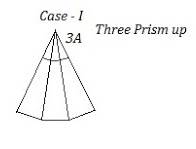If three identical prisms are combined, is it possible to pass a beam that emerges undeviated and undispersed?
Since the prisms are identical, they can be combined in two ways - First, having each one's vertex near each other (at the top) and second, two vertices and one base on the top.
a. The first case will make it a prism with the refracting angle three times larger. So there will be a deviation as well as dispersion.

b. The second case will make it a similar prism to one of the identical prisms with the same refracting angle. So in this case also there will be a deviation and the dispersion.
Hence the answer is "No".
1
